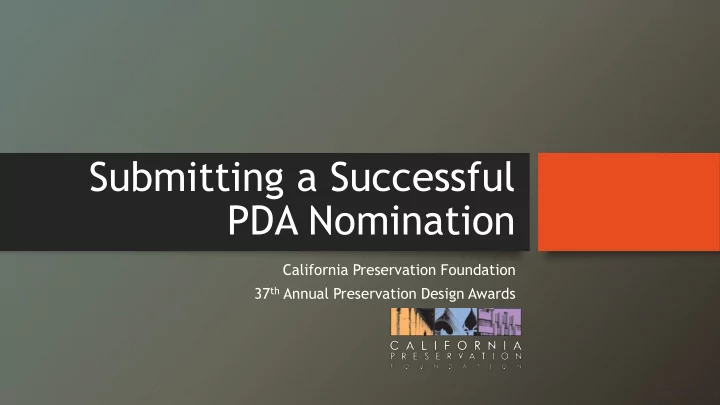

Submitting a Successful PDA Nomination California Preservation Foundation 37 th Annual Preservation Design Awards
California Preservation Foundation Staff: Cindy Heitzman Jon Haeber Christine Madrid French Executive Director, California Field Services Director, Director of Development & Preservation Foundation California Preservation Marketing, California Preservation Foundation Foundation Design Award Co-Chairs: Bill Schaeffer Andrew Wolfram Cello & Maudru Construction TEF Design
The Three Components of a Nomination 1. The Entry Form Affiliate List • Image Release • Signatures of Principal Participants • 2. The Narrative 3. The PowerPoint Slides
The Entry Form Five-step Online application with sequential steps. Accessible by visiting californiapreservation.org/awards Overview of Preservation Design Awards application process.
The Entry Form Please complete the following steps in succession 1.Entry Form & Affiliate Spreadsheet (Step 1) 1. Optional Downloadable Worksheet for Upload Explanation of each step Later: Project Affiliates Spreadsheet of the application 2.Complete and Sign Application Release (Step 2 of 5) 1. Optional Downloadable Release Form: Application process. Release Form 3.Complete Narrative & Questionnaire (Step 3 of 5) 1. Optional Downloadable Word document. This is for your use in drafting the information before entering it into the required online application 4.Upload All Required Materials & Complete Final Checklist (Step 4 of 5) 5.Payment of Application Fees (Link emailed to you after upload and final checklist is complete)
The Entry Form 8 Award Categories: 1. Preservation 2. Rehabilitation 3. Restoration 4. Reconstruction 5. Contextual In-Fill 6. Cultural Resource Studies, Reports 7. Craftsmanship/Preservation Technology 8. Archaeology and/or Interpretive Exhibits
The Entry Form Online Entry Form: 1 st of 5 Steps
Important points about the Application: Deadline for nominations is June 22, 2020 at 5 p.m. Pacific Time • Qualifying Buildings • Qualifying projects include historical buildings, structures • Properties on, or determined eligible for, national, state or local historical registers or inventories
Important points about the Narrative: You should present the project from the perspective of the jury: They’ve never seen it. They don’t know what existed prior to the project. They don’t know who worked on it (if they do…or if they worked on it, they may recuse themselves from the discussion) You need to make the case in words and images. Your descriptions AND the quality of your photographs are very important.
The Narrative: Why is the project is noteworthy? What is the Architectural/ Historical/Cultural Significance of the Project? Is the project listed on the National Register? Is it significant locally? Does it comply with the Secretary of the Interiors Standards? Can be a model for adaptive reuse or uses innovative approaches to solving structural, architectural or adaptive reuse challenges? Does the building fulfill an important social, cultural or economic function?
The Narrative: Overview Summary of the Project (40 words maximum)
The Narrative: Project Narrative (150 word maximum)
The Narrative: Is the site listed or determined eligible for the National or California Registers, or local landmark, historic district or inventory?
The Narrative: Describe the site or building's HISTORIC significance (i.e. what makes the project significant as an historic site) (150 word maximum)
The Narrative: Describe why the project deserves an award, specifically addressing work conducted by your team that is outstanding or of an exceptional nature? (250 word maximum)
The Narrative: Describe the condition immediately prior to the work of the project? Where, When and How did the project start? (150 word maximum)
The Narrative: What were the Features/Structures involved in the project? (100 word maximum)
The Narrative: Explain the basis of decision to include applying of the Secretary of the Interior’s Standards or other governing standards (100 word maximum)
The Narrative: Explain the contextual importance to the surrounding environment (150 word maximum)
The Narrative: Optional Explain any technology or practices of the project which promote environmental design, material and energy conservation (150 word maximum, optional)
The Narrative: Dates of original construction and alteration; period of significance (50 words maximum)
The Narrative: Optional If the project is a Cultural Resource Report/Study, how is report being used within the community?
The Narrative: Optional Any other information the Applicant would like the Jury to receive? (Optional)
The PowerPoint Slides What the Jury Sees and Hears: Rehabilitation Project
The Slides What the Jury Sees and Hears: Historic Context Report
Questions? For more information, visit our website at californiapreservation.org/awards Email pda@californiapreservation.org Or call 415-495-0349
Recommend
More recommend